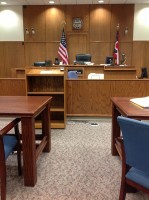Widgetized Section
Go to Admin » Appearance » Widgets » and move Gabfire Widget: Social into that MastheadOverlay zone
Judicial Branch Response to Disasters
The views expressed are those of the author and do not necessarily reflect the views of ASPA as an organization.
By Brian J. McLaughlin
February 23, 2016
While court personnel are not true first responders, the judicial branch fulfills a critical role in restoring order in the aftermath of natural and human-instigated disasters. The judiciary’s emergency management responsibility begins moments after a disaster and can stretch several years as the resulting litigation proceeds through the court system. Succeeding in the disaster response requires the investment of judicial leaders in a collaborative approach with stakeholders.
Managing the Immediate Aftermath
Unfortunately, the judicial branch is familiar with catastrophic events, and has a professional history of developing emergency management best practices. Integrating the courts into emergency command systems is a key lesson from the Sept. 11 attacks. According to the National Center for State Courts, effective court emergency management programs interface with external agencies and incorporate all facets of operations. Building relationships with the Federal Emergency Management Agency (FEMA) and public safety leaders is paramount in the judiciary’s disaster response planning. The National Association for Court Management advises: “A clear-cut, widely disseminated disaster recovery plan is critical to help minimize court downtime and resume normal business operations as quickly as possible.” Continuity of Operations (COOP) planning and training is essential for the judicial branch. Today, all federal courts in the United States have COOP plans that ensure mission essential functions continue when normal operations are disrupted. For example, the United States District Court for the Central District of California created an informative COOP website that provides excellent resources.
 In the aftermath of a disaster, the immediate concern is the safety of judges, court personnel, lawyers and members of the public within the courthouse. Once people and facilities are secure, the focus turns to ensuring the functioning of communications, information systems and court operations. Using a collaborative systems approach with justice system partners, court leaders strive to minimize operational disruptions. Courts must have the ability to hold time-sensitive and constitutionally mandated hearings, issue warrants and orders, and hear emergency applications related to the disaster.
In the aftermath of a disaster, the immediate concern is the safety of judges, court personnel, lawyers and members of the public within the courthouse. Once people and facilities are secure, the focus turns to ensuring the functioning of communications, information systems and court operations. Using a collaborative systems approach with justice system partners, court leaders strive to minimize operational disruptions. Courts must have the ability to hold time-sensitive and constitutionally mandated hearings, issue warrants and orders, and hear emergency applications related to the disaster.
Working with other local, state, and federal organizations, courts can utilize alternate locations if the courthouse is inaccessible. Judiciary employees may remotely access case management systems and telework if necessary. Additionally, a disaster may only affect part of a jurisdiction. Unaffected court facilities may be used by other government agencies in need of secure space during their response.
Courts must also provide filing access for those parties bound by a filing statute of limitations. When necessary, impacted jurisdictions can issue an order tolling case activity during a period of operational disruption. Finally, re-opening the courthouse doors can convey a return to normalcy after a challenging time.
Managing the Resulting Litigation
On July 2, 2015, United States District Court Judge Carl J. Barbier settled all federal, state and local claims against BP for the 2010 Deepwater Horizon oil spill in the Gulf of Mexico for a record $18.7 billion. Judge Barbier’s “masterful” management of this complex litigation highlights the pivotal role that judges and court personnel play in successfully handling disaster-related cases. This role includes strategically using judicial and clerk’s office resources to manage fairly and efficiently the resulting filings. Disaster-related cases can have similar parties, fact patterns and legal issues. These can include civil suits (e.g., injury and property damage), family cases (e.g., guardianship and parenting), and criminal charges (e.g., rioting and insurance fraud). Once disaster-related cases are filed, court leaders can establish an appropriate plan to effectively manage the resulting wave of litigation.
For example, at the United States District Court for the District of New Jersey, Chief Judge Jerome B. Simandle called a public meeting for homeowners, attorneys and other interested groups as part of a collaborative planning effort to manage the deluge of Superstorm Sandy litigation after the 2012 disaster. In similar situations, the use of differentiated case management practices can tailor the court process to the unique needs of disaster-related cases. Relevant practices can include judges and court administrators intervening early to monitor the discovery process, closely supervising motion practice and facilitating the best use of settlement resources. Jurisdictions may choose to consolidate or track together similar cases. Alternative Dispute Resolution (ADR) programs such as mediation and arbitration can help expedite the resolution of cases, while saving the costs of lengthy trials for the parties and the court.
Summary
Writing in the Howard Law Journal, United States Court of Appeals for the Seventh Circuit Chief Judge Diane Wood argues, “If courts are unavailable or unable to function, as was the case following Hurricane Katrina, little stands between the citizenry and the breakdown of the rule of law.” Mobilizing the justice system after disasters is essential to social stability and protecting individuals, families, businesses and public institutions. Indeed, judicial leaders are now valuable members of the emergency management network. Carefully managing the disaster response process helps preserve the reputation of the judicial branch as a stable and trustworthy institution.
Author: Brian J. McLaughlin, MS, MPA is an adjunct faculty member with the Master of Public Administration program at Villanova University and has administrative experience with courts at the local, state and federal levels. This article presents the personal views of the author and does not represent the New Jersey Judiciary.


Follow Us!